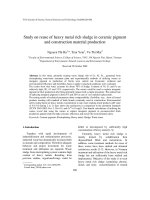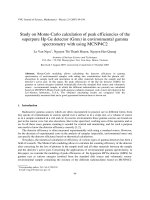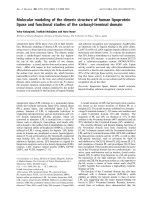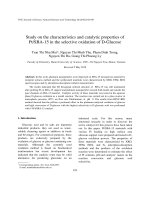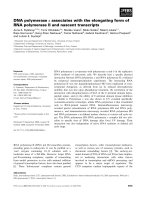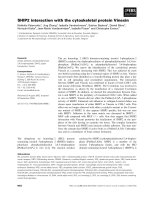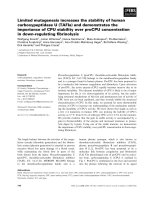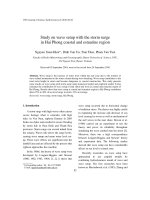Báo cáo " Study on wave setup with the storm surge in Hai Phong coastal and estuarine region " pot
Bạn đang xem bản rút gọn của tài liệu. Xem và tải ngay bản đầy đủ của tài liệu tại đây (114.81 KB, 8 trang )
VNU Journal of Science, Earth Sciences 26 (2010) 82-89
82
Study on wave setup with the storm surge
in Hai Phong coastal and estuarine region
Nguyen Xuan Hien*
, Dinh Van Uu, Tran Thuc, Pham Van Tien
Faculty of Hydro-Meteorology and Oceanography, Hanoi University of Science, VNU,
334 Nguyen Trai, Hanoi, Vietnam
Received 05 September 2010; received in revised form 24 September 2010
Abstract. Wave setup is the increase of water level within the surf zone due to the transfer of
wave-related momentum to the water column during wave-breaking. Wave setup contributes to the
total water height in storm and become dangerous to coastal construction. This study presents
some results on wave setup with storm surge using numerical model and empirical model. It also
estimates the contribution of wave setup in total storm tide level at coastal and estuarine region of
Hai Phong. Results show that wave setup at coastal and estuarine region in Hai Phong contributes
about 25% to 40% of sea level surge in storm, 32% on average.
Keywords: wave setup, storm surge, Hai Phong.
1. Introduction
∗
A storm surge with high waves often causes
severe damage when it coincides with high
tides. In Viet Nam, typhoon Damrey in 2005
broke sea dykes and resulted in severe flooding
by storm tide in Nam Dinh and Thanh Hoa
provinces. Storm surge can several inland from
the estuary. Waves ride above the surge levels,
causing wave runup and mean water level set-
up. These wave effects are significant near the
landfall area and are affected by the process that
typhoon approaches the coastline.
In the 1960s, the theory of wave setup were
developed by Longuet-Higgins and Stewart
(1960, 1962, 1963, 1964) [1, 2], it shows that
_______
∗
Corresponding author. Tel.: 84-4-37730409.
E-mail:
wave setup occurred due to horizontal change
of radiation stress. The theory was highly useful
in explaining the increase and decrease of sea
level causing by waves as well as mechanism of
the surf waves in the near shore. Bowen et al.
(1968) carried out an experiment to test the
theory and prove its reliability throughout
simulating the wave crashed onto the shore [3].
Moreover, there was a high correspondence
between Longuet-Higgins and Stewart’ theory
and experiment data. The following studies
showed that wave setup can have considerable
effects on sea level in coastal zone.
Recently researches on wave setup have
approached to use coupled models by
combining hydrodynamics model of wave and
wave setup. The first researches have been
known as Mastenbroek et al. (1993), Zhang and
N.X. Hien et al. / VNU Journal of Science, Earth Sciences 26 (2010) 82-89
83
Li (1997) [4, 5]. However, in these studies,
authors did not considered all the effects in
breaking wave zone due to using wave model
for large area (WAM). Another approach,
Shibaki et al. (2001) showed that, by adding
radiation stress to the movement equation,
obtained results were better than in the case
separated run of the models to calculate wave
setup and storm surge. Recently, Funakoshi et
al. (2008) studied wave setup by using two
models, Advanced Circulation Model
(ADCIRC) to simulate storm surge, and the
SWAN to compute wave field [6]. This
research indicated that wave setup accounted
for about between 10 and 15 percent of total sea
level rise. Some other notable researches
include Hanslow and Nielsen (1993), Gourlay
(1992) Raubenheimer et al. (2001); the
experimental formulas have widely been
applied with high reliability (Happer et al.,
2001) [7-10].
In Viet Nam, although some studies on
storm surges have been conducted in the past,
however approach on wave setup and the
assessments of its roles in total surge are not
clear yet. In this study, storm wind model
Boose et al. (1994) with the SWAN model are
applied to simulate the wave field, and used
some experimental formulas are used to
calculate wave setup at some locations near Hai
Phong coastal area for several storms.
2. Model Description
2.1. Typhoon wind and wave model.
The Boose et al. model (1994) was adopted
to produce atmospheric pressure and wind
fields of typhoons. A third-generation wave
model, SWAN (Simulating Waves Nearshore),
was used to simulate the wave field in the
investigated area.
2.2. Wave setup model
The empirical wave setup of Hanslow &
Nielsen (1993), Gourlay and Raubenheimer
was used in this study. These formulas are
follows:
- Hanslow & Nielsen (1993)
00
048.0 LH
rmsw
=η (5)
where
w
η is the wave setup at the shoreline,
H
rms0
is the deep water rms wave height and L
0
is the deepwater wave length, which is
calculated by:
π
2
2
0
P
gT
L = (6)
in which
P
T
is the pick wave period from the
numerical wave model simulation at the
selected output point.
- Gourlay (1992):
4.0
00
35.0 ξη
rmsw
H=
(7)
in which
0
ξ
is the surf similarity parameter.
00
0
/
tan
LH
α
ξ = (8)
in which
α
tan
is the beach slope.
- Raubenheimer (2001):
)003.0019.0(
1−
+=
avsow
H βη (9)
in which H
s0
is the deepwater significant wave
height, and
av
β is the beach slope:
x
h
av
av
∆
=β (10)
N.X. Hien et al. / VNU Journal of Science, Earth Sciences 26 (2010) 82-89
84
in which x
∆
is the width of the surf zone and
the average water depth:
∫
+
∆
= dxh
x
h
av
)(
1
η (11)
where h is the still water depth, and
η
is the
wave setup measured from the still water level.
Note that, for a planar beach,
av
β would be
approximately equal to 1/2 of the beach slope.
These empirical water setup equations were
developed from field and laboratory data in
which moderately sized deepwater waves
impinges almost directly on the coastline. The
surf zones during these conditions would vary
with wave parameters but would be several
hundreds of meters wide. These formulas are
based on an assumption of steady state
conditions during which wave induced currents
and water level reach an equilibrium condition.
The situation during severe tropical cyclones
are different from conditions during which
these field and laboratory data were collected.
In order to obtain deepwater significant wave
height needed for the above mentioned
equation, the procedure was as follows: Firstly,
the significant wave height H
s0
at the inshore
model output point is deshoaled to the
deepwater value to obtain:
s
go
g
s
H
C
C
H =
0
(12)
where,
g
C
and
0g
C
are wave group speeds at
wave output point and deepwater, respectively,
given as:
π
4
0
gT
C
g
=
(13)
+=
p
p
p
p
g
L
h
gT
Lh
Lh
C
π
ππ
π
2
tan
2)/4sinh(
/4
1
2
1
(14)
In which,
p
L is the wavelength of the peak
frequencies of the spectrum given as:
=
p
p
p
L
h
gT
L
π
π
2
tan
2
2
(15)
The significant wave height in equation 5
and 7 is converted to an rms using:
0
2
1
srmso
HH = (16)
3. Model calibration
The results of calibration of the wind fields
show that the typhoon model of Boose given a
good simulation of wind velocity in the Hon
Dau station for the two storms [11]. Therefore,
this model is used to calculate the meteorology
field which is input for the wave model and
wave setup in storm.
3.1. Results of wave field.
Figure 1 shown the couple grid in SWAN
model.
N.X. Hien et al. / VNU Journal of Science, Earth Sciences 26 (2010) 82-89
85
Figure 1. The computation mesh and domain in SWAN model.
The large domain (D0) is from 105.75
0
E to
108.50
0
E and from 19.5
0
N to 21.75
0
N with the
resolution of 500m. The small domain (D1) is
from 106.6
0
E to 107.008
0
E and from 20.6
0
N to
20.93
0
N with the resolution of 100m, time step
is 15 minutes. Table 1 shows the results of
wave characteristics and comparison between
computed with the observation data at the Bach
Long Vi station.

